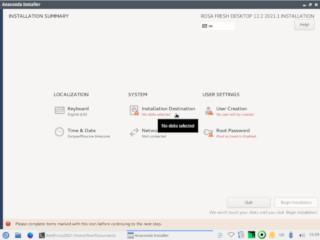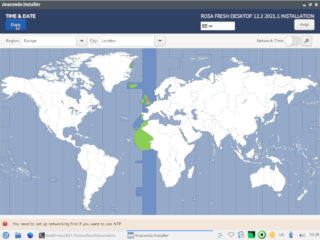best viewed with NetSurf

Installing ROSA.FRESH.LXQT.12.2.i686
The installation is relatively similar to that of Fedora 34.
 Setting language
Setting language
|
 ROSA.FRESH.LXQT.12.2.i686
ROSA.FRESH.LXQT.12.2.i686
|

|

|

|

|

|

|

|

|
Partition /dev/sda3 created with fdisk, from the previous distribution, also required a filesystem built with mkfs, so I stopped the installation, built the necessary filesystem and started the installation again.
/sbin/mkfs.ext4 /dev/sda3

|

|
Now it worked.

|

|

|
 Begin installation
Begin installation
|
After installation, adding partitions /dev/sda4, /dev/sda2 (swap) and /dev/sda1 to /etc/fstab:
x@rosa2021 ~ $ su -c '/sbin/blkid'
Password:
/dev/sda4: UUID="1caeb78f-38b4-482f-b050-770ab495f516" BLOCK_SIZE="4096" TYPE="ext4" PARTUUID="92121ea4-04"
/dev/sda2: UUID="a40d4259-577b-41be-9644-03f53c7a8926" TYPE="swap" PARTUUID="92121ea4-02"
/dev/sda3: UUID="0bd207ed-341a-4f85-aa83-1b1af93d0cdc" BLOCK_SIZE="4096" TYPE="ext4" PARTUUID="92121ea4-03"
/dev/sda1: UUID="fc77fff9-9642-48b1-9ca3-df34675e9032" BLOCK_SIZE="4096" TYPE="ext4" PARTUUID="92121ea4-01"
cd /media/
su -c 'mkdir sda4;mkdir sda1'
cd /etc/
su -c 'vi fstab'
# # /etc/fstab # Created by anaconda on Thu Dec 21 16:51:59 2023 # # Accessible filesystems, by reference, are maintained under '/dev/disk/'. # See man pages fstab(5), findfs(8), mount(8) and/or blkid(8) for more info. # # After editing this file, run 'systemctl daemon-reload' to update systemd # units generated from this file. # UUID=0bd207ed-341a-4f85-aa83-1b1af93d0cdc / ext4 defaults 1 1Added 3 lines:
UUID=1caeb78f-38b4-482f-b050-770ab495f516 /media/sda4 ext4 defaults 1 2 UUID=a40d4259-577b-41be-9644-03f53c7a8926 none swap defaults 0 0 UUID=fc77fff9-9642-48b1-9ca3-df34675e9032 /media/sda1 ext4 noauto 0 0 :w :qThen disabled some services:
su
systemctl disable cpupower.service
systemctl disable crond.service
systemctl disable cups.service
systemctl disable atd.service
systemctl disable dmraid-activation.service
systemctl disable irqbalance.service
systemctl disable mdmonitor.service
systemctl disable rpcbind.service
systemctl disable smb.service
systemctl disable nmb.service
systemctl disable sshd.service
systemctl disable avahi-daemon.service
systemctl disable avahi-dnsconfd.service
systemctl disable avahi-daemon.socket
systemctl disable canberra-system-bootup.service
systemctl disable getty@.service
systemctl disable rtkit-daemon.service
systemctl disable systemd-pstore.service
systemctl disable wsdd.service
systemctl disable dm-event.socket
systemctl disable pcscd.socket
systemctl disable rpcbind.socket
systemctl disable machines.target
systemctl disable reboot.target
systemctl disable cryptsetup.target
systemctl disable remote-fs.target
systemctl disable remote-cryptsetup.target
systemctl disable dnf-makecache.timer
systemctl disable fstrim.timer
systemctl disable logrotate.timer
systemctl disable man-db.timer
exit
systemctl list-unit-files
q
sistemctl disable *.service
systemctl stop *.service
If nothing bad happens, you can safely disable the service. If something bad does happen, you can restart the computer and everything will be fine.Now about the boot file, /etc/default/grub:
cd /etc/default/
su -c 'vi grub'
GRUB_GFXPAYLOAD_LINUX=keep
GRUB_DISABLE_RECOVERY=true
GRUB_DISTRIBUTOR="ROSA"
GRUB_GFXMODE=1024x768,1024x600,800x600,640x480
GRUB_DEFAULT=saved
GRUB_SAVEDEFAULT=true
GRUB_TIMEOUT="10"
GRUB_CMDLINE_LINUX_DEFAULT='splash=silent logo.nologo quiet'
GRUB_DISABLE_OS_PROBER=false
GRUB_THEME="/boot/grub2/themes/rosa/theme.txt"
GRUB_BACKGROUND="/boot/grub2/themes/rosa/terminal_background.png"
GRUB_CMDLINE_LINUX="resume=UUID=a40d4259-577b-41be-9644-03f53c7a8926 rhgb quiet"
GRUB_ENABLE_BLSCFG=true
GRUB_PASSWORD_PROTECT_ONLY_EDITING=true
GRUB_DISABLE_RECOVERY=true
GRUB_DISTRIBUTOR="ROSA"
GRUB_DEFAULT=saved
GRUB_SAVEDEFAULT=true
GRUB_TIMEOUT="5"
GRUB_DISABLE_OS_PROBER=false
GRUB_CMDLINE_LINUX="resume=UUID=a40d4259-577b-41be-9644-03f53c7a8926 quiet selinux=0"
GRUB_ENABLE_BLSCFG=true
GRUB_PASSWORD_PROTECT_ONLY_EDITING=true
su -c '/usr/sbin/grub2-mkconfig -o /boot/grub2/grub.cfg'
reboot
su
rpm -e dnfdragora-qt-2.1.2-6.noarch dnfdragora-2.1.2-6.noarch dnfdragora-common-2.1.2-6.noarch
dnf remove trojita
dnf remove audacious
dnf remove telegram
rpm -e qps-2.4.0-3.i686 task-lxqt-1.0.0-2.noarch
rpm -e ffmpeg-4.4.1-1.i686 rosa-media-player-1.6.11-15.i686
rpm -e mplayer-1.4-3.i686 mencoder-1.4-3.i686
rm /etc/profile.d/termhelper.sh
dnf remove xscreensaver
exit
dnf install gimp